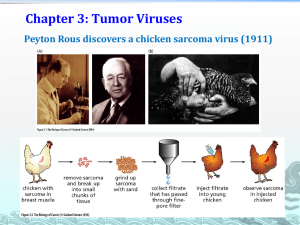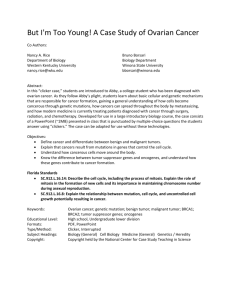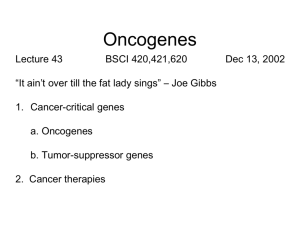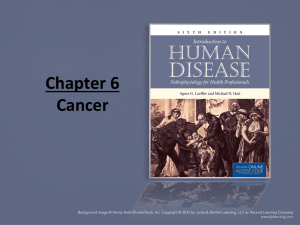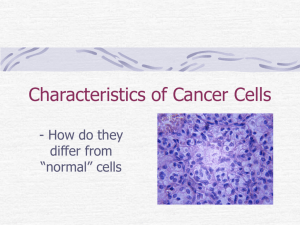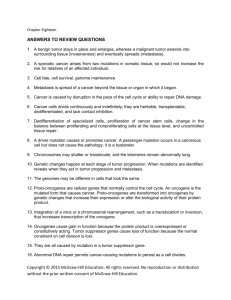Lecture 12: Cancer: a cellular perspective
advertisement
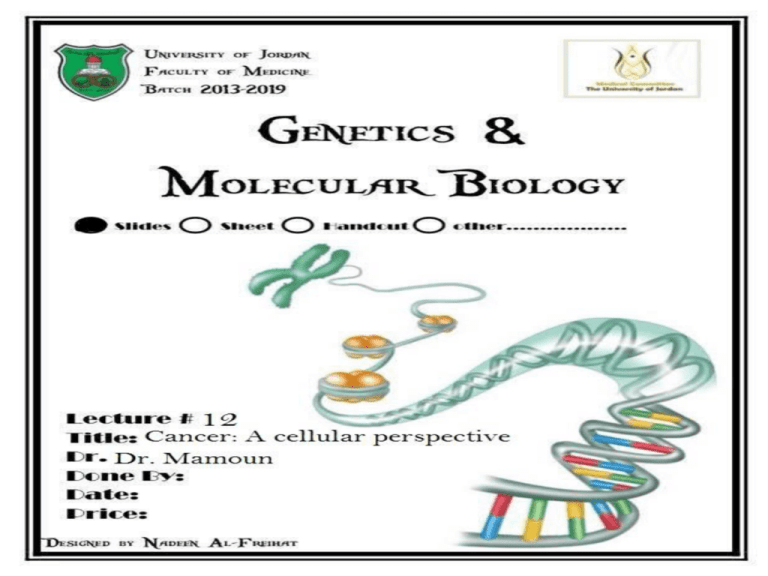
Lecture 12: Cancer: a cellular perspective Dr. Mamoun Ahram Faculty of Medicine Second year, Second semester, 2014-2014 Principles of Genetics and Molecular Biology What is cancer? A tumor is any abnormal proliferation of cells. A benign tumor is confined to its original location. A malignant tumor (cancer) is capable of both invading surrounding normal tissue and spreading throughout the body via the circulatory or lymphatic systems (metastasis). It develops from a multistep process involving mutation with progressively increasing capacity for proliferation, survival, invasion, and metastasis. Processes of tumorigenesis Tumor initiation: a genetic alteration leading to abnormal proliferation of cells into a tumor Tumor progression: accumulation of mutations within cells of the tumor population. Some of these mutations confer a selective advantage to the cell, such as more rapid growth. Tumor heterogeneity Environmental cause of cancer Carcinogens (substances that cause cancer) are of two types: Initiators: induce genetic mutations Radiation, viral, and chemical carcinogens (chemicals in tobacco smoke and aflatoxin) Promoters: stimulate cell proliferation The phorbol esters stimulate cell proliferation by activating protein kinase C. Hormones (estrogens) increase risk of female cancers. Pathogens Features of cancer (1) Clonality Accumulation of genetic mutations Uncontrolled proliferation Autocrine growth stimulation Reduced cell-cell contact and cell-matrix adhesion Features of cancer (2) Density-dependent inhibition Contact inhibition Invasiveness and extracellular proteolysis Features of cancer (3) Angiogenesis Lack of differentiation Loss of apoptotic capability Cessation of senescence Oncogenes and tumor suppressor genes Oncogene Tumor suppressor gene A gene capable of inducing one or more characteristics of cancer cells when activated. A gene whose inactivation leads to tumor development. A proto-oncogene: a normal cell gene that can be converted into an oncogene. Viral oncogenes Oncogene abl akt erbA erbB raf rasH rasK src Virus Abelson leukemia AKT8 virus Avian erythroblastosis-ES4 Avian erythroblastosis-ES4 3611 murine sarcoma Harvey sarcoma Kirsten sarcoma Rous sarcoma Rous sarcoma virus Oncogenes and signal transduction Oncogene proteins act as: Growth factors (e.g., EGF) growth factor receptors (e.g., ErbB) Intracellular signaling molecules (Ras and Raf) transcription factors (e.g., fos) Oncogenes and receptors Oncogenes and transducers A single nucleotide change, which alters codon 12 from GGC (Gly) to GTC (Val), is responsible for the tumorigenic activity of the rasH oncogene. The mutation maintains the Ras proteins constitutively in the active GTP-bound conformation. Oncogenes and transcription factors Normal cell Tumor cell Oncogenes and cell survival The Akt pathway involving protooncogenes (ligands, receptors, PI-3 kinase, and AKT) promotes cell survival by inhibiting proapoptotic proteins and inducing anti-apoptotic proteins. Oncogenes and cell differentiation Mutated forms of both the thyroid hormone receptor (ErbA) and the retinoic acid receptor (PML/RARα) act as oncogene proteins in human acute promyelocytic leukemia where the mutated oncogene receptors block cell differentiation and maintain the leukemic cells in an actively proliferating state. TSG and proliferation and survival The tumor suppressor protein PTEN is a lipid phosphatase that dephosphorylates PIP3 into PIP2. It counters the action of the oncogenes PI 3kinase and Akt, which promote cell survival. TSG and cell cycle Rb inhibits progression past the restriction point in G1. Cdk4/cyclin D complexes promote passage through the restriction point by phosphorylating and inactivating Rb. Inactivation of Rb results in increased cell cycle progression and tumor formation. Role of p53 Loss of p53 prevents DNA damage-induced cell cycle arrest, leading to increased mutation frequencies and a general instability of the cell genome contributing to further alterations in oncogenes and tumor suppressor genes during tumor progression. A mechanism of viral carcinogenesis The E6 and E7 proteins of the human papillomavirus (HPV) block the function of the cellular Rb and p53 proteins. In particular, E7 binds to Rb, and E6 stimulates the degradation of p53 by proteolysis. The multistep genetic model for the formation of colorectal cancer Inactivation of TSGs and the activation of oncogenes leading to dyfunctional pathways. Accumulation of mutations in a sequential manner, with mutations of some genes preceding that of others. -catenin Fearon ER, Vogelstein B. A genetic model for colorectal tumorigenesis. Cell. 1990;61:759767. Personalized medicine is the way Doctors are men who prescribe medicines of which they know little, to cure diseases of which they know less, in human beings of whom they know nothing. Voltaire (1694-1778) A future outlook "Here's my sequence...” New Yorker, 2007 Remember: Diseases are proteomic

